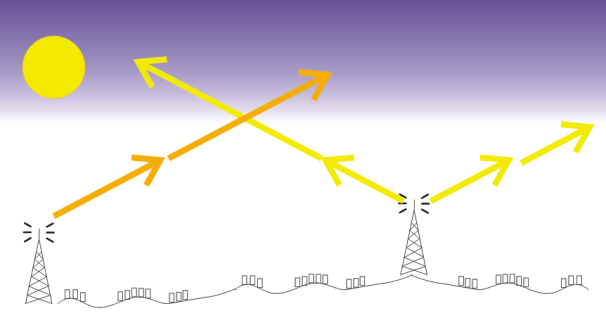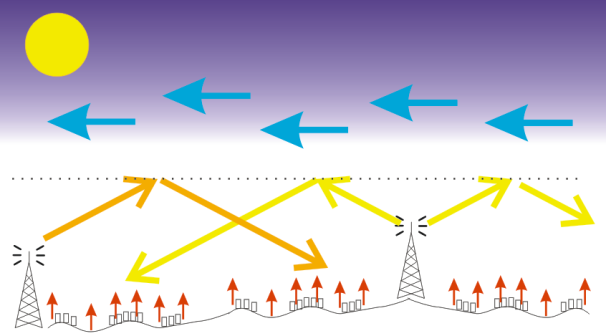What is the Inversion Effect and why does it effect my Freeview TV reception?
 Brian Butterworth published on UK Free TV
Brian Butterworth published on UK Free TV Under normal circumstances, the signals from each television transmitter can only be received by those homes and businesses that have aerials that have a direct line-of-sight to the transmitter.
(The Inversion Effect is also known as "Tropospheric Ducting")

The part of the signal from the transmitter that is directed upwards simply escapes into space and are lost.
When there is high atmospheric pressure (Met Office - Surface pressure charts) as the sun heats up the ground the warm air gets trapped underneath the colder air higher up. At the point where the warm air gets trapped under the cold air this creates a layer that is, in effect, a mirror for the television signals.

This means that signals that would otherwise be impossible to receive can suddenly effect your television reception.
The digital television signal uses a format called COFDM (coded orthogonal frequency division multiplexing) and this incorporates the ability to ignore reflected digital signals.
However, analogue television signals did not co-operate with each other and the picture quality is reduced. The very weak digital signals that were used before digital switchover for Freeview were badly effected by interference from reflected signals from adjacent analogue transmissions.
I recommend you look at the Tropospheric Ducting Forecast for VHF and UHF Radio and TV page for a current forecast - yellow, orange, red, and pink indicate that conditions are perfect for the effects listed above.
Links to current pressure data
dave sexton: Those in Lincolnshire, for example, whose aerials point to Belmont can have difficulties because broadcasts from the Continent which is in the same direction carry across the water.
There's not a lot that can be done. Even if another transmitter is available you never know whether that might be affected, the randomness of the inversion effect being unpredictable.
If you are using Rowridge transmitter which is on the Isle of Wight then you might benefit from switching your aerial to vertical, this being because it transmits horizontally and vertically. If your aerial faces France then this will help reduce the likelihood of co-channel interference from there because it uses horizontal polarisation for its main transmitters.
| link to this comment |
6:09 PM
Annan
If my UK free TV settings are clear, why does adverse weather conditions result in poor to no reception
| link to this comment |
Philip's: mapP's Freeview map terrainP's terrain plot wavesP's frequency data P's Freeview Detailed Coverage
11:59 PM
Phil D - that is rather what this whole thread is about.
Though it is confused by the title saying "effect" when it should be "affect"
| link to this comment |
1:52 AM
Phil Deasey: Since the title of this thread only tends to appear in really good, weather, not bad, you might want to check your system - if your egtting a problem during raid or just after, most likely its rain getting into the cabling.
| link to this comment |
11:22 PM
Swindon
Could you please find out why my TV (SN1 4EL, 2 Penfold Gardens) has got such terrible reception. In the morning and in the evening I can't get any station without a perfect signal. However during the day the reception is fairly good, so that I can see some of the Commonwealth Games.
| link to this comment |
Peter's: mapP's Freeview map terrainP's terrain plot wavesP's frequency data P's Freeview Detailed Coverage
8:11 AM
Peter Royle: Your particular locality sits in an almost direct line between the Oxford and Mendip transmitters, likewise its possible to receive Freeview from either station on each end of your aerial.
Although most aerials are seen to be facing towards Mendip (@ 42 miles / 239 degrees) and which is indicated as providing a slightly better signal, there are however a number of aerials facing in the direction of Oxford (@ 31 miles / 57 degrees), this being the case its really a question of which station your aerial is facing towards? then ensuring that your TV is actually tuned to that station and not the one being picked up on the reverse of your aerial, which on "some" types can be very much lower than the signal being received from the front.
Carry out a signal check on both BBC1 and ITV and note the Mux number seen along with the strength / quality indication, then check the number seen with the following.
Mendip - BBC Ch49 / ITV Ch54.
Oxford - BBC Ch53 / ITV Ch60.
By the way, its noticed that there are a number of trees in your area, and if any are in line with the direction your aerial is facing towards then the moisture content of the foliage can cause variations in the signal level being received.
| link to this comment |
7:33 AM
Has the power of the satellites been improved when they re_jigged them earlier in the year? Just thinking about interference to the signal in heavy rain. I have just installed a free sat recorder to compliment my free view PVR. Cheers,........Dave.
| link to this comment |
9:42 PM
Dave Hagen:
The power output of any satellite transponder is a function of the Travelling Wave Tube (TWT) design and construction and is almost never changeable. What does get changed sometimes is which of the several TWTs are used for which beam and the aim of the on-board dishes are sometime adjusted slightly. Remember that the satellites are unmanned and remotely controlled from a ground station.
The effect of heavy rain is an absorption phenomenon that is entirely natural and is not technically interference. It comes about due to the size of a water molecule relative to the wavelength of the downlink signals, normally in the Ku band from the Astra (used by Sky) satellites. Some other satellites use a lower frequency range and in the USA they have services running in C band, not too different from the signals used for 802.11n WiFi in the upper 5 GHz band, which is almost unaffected by water absorption.
| link to this comment |
9:12 PM
MikeP: Thanks Mike you have just frazzled my brain but thanks for taking the time to respond.
| link to this comment |
